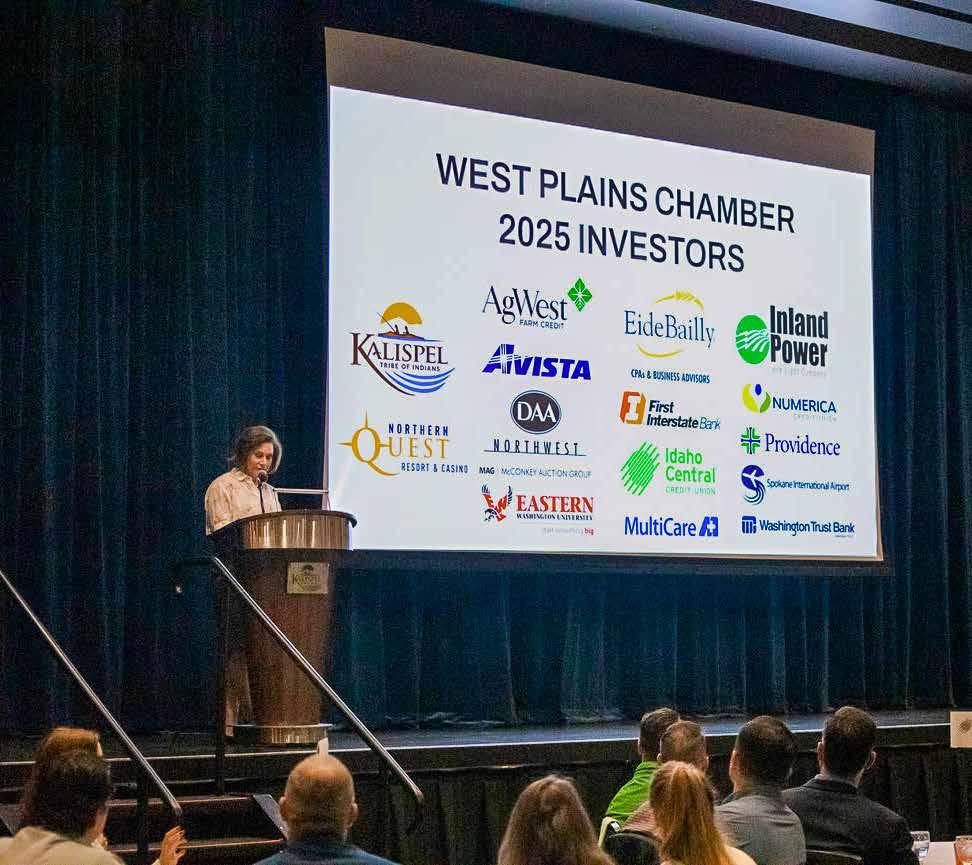










By Airman 1st Class Samantha Thorn
92nd Air Refueling Wing
Airmen assigned to the 92nd, 141st, and the 22nd Air Refueling Wings conducted exercise Titan Fury 25-2 at Fairchild Air Force Base, Washington, March 17-21, 2025.
Fairchild Air Force Base Airmen participated in an exercise showcasing their ability to rapidly prepare and deploy KC-135 Stratotanker crews. These crews are trained and equipped for the critical task of aerial refueling, ensuring the readiness and effectiveness of both the U.S. Strategic Command and U.S. Transportation Command.
The 92nd ARW’s capabilities directly support all components of America’s strategic deterrent force.
“Titan Fury isn't just about testing our individual skills, it's about honing the 92nd ARW's ability to deliver global reach, whether it's keeping our bombers fueled for deterrence patrols, rapidly deploying troops, or providing life-saving aeromedical evacuations,” said Col. Chad Cisewski, 92nd ARW commander.
“The ability to provide global reach is a cornerstone of American airpower, and this exercise validates Total Force readiness to execute our priority missions in the most demanding environments."
The seamless integration of support and operational functions form the backbone of rapid global mobility, projecting power and demonstrating unwavering readiness at a moment's notice.
1st Lt. Jacob Johnson, one of the two generation superintendents during Titan Fury 25-2, explained that this complex exercise requires months of meticulous planning and cross-functional collaboration, carefully balancing aircraft availability, resource allocation, and personnel to ensure successful execution.
“Our goal is to successfully generate as many aircraft in the shortest amount of time possible to support the wing’s mission in strategic deterrence requirements,” remarked Johnson. “This requires Airmen at every level to fully understand intent from higher echelons of command and the importance of why we are generating high numbers of aircraft.”
The mission's success hinges on a unified force working together to demonstrate power projection. Each team, from logistics to maintenance to operations to support, plays a critical role, their combined efforts weaving a tapestry of readiness. This synchronized effort ensures a robust and agile posture, ready


A.J. Mauchard
Nominated by Baseball
A.J. has a .500 batting average the last three games. He threw a complete game win on the mound over Timberlake with 11 strikes outs, no walks and only two hits allowed. A.J. has taken on a leadership role on the team and is a role model on and off the field.

Nominated by the English Dept
Sam goes above and beyond on her writing assignments and has grown in her creativity and skills. She is always willing to help other students, provide feedback, and is patient/calm. Sam gets excited to learn and write!

U.S Air Force Airman Brandon Krause-Mahan, a fuels management specialist, simulates fueling a KC-135 Stratotanker during exercise Titan Fury 25-2 March 17, 2025.
to face any challenge.
“Titan Fury is a great opportunity for the wing and security forces to hone their skills and provide world class security and project power,” stated Master Sgt. William Jorgensen, the 92nd Security Forces Squadron operations superintendent.
This exercise showcases rapid global mobility across three different wings, demonstrating Team Fairchild’s number one priority and immediately deploying essential cargo anywhere in the world in support of national objectives.
“The traffic management office will conduct initial inspections on


Nominated by the Math Dept.
Madi is so extremely helpful as a TA and in math class. She can be paired with any student and she will not only get along with that student, but will also help them if/when they don’t understand a particular concept. Madi is going to do great things in her future!
tasked cargo as well as in-checking and manifesting cargo through the Cargo Movement Operations System (CMOS),” commented Staff Sgt. Jake Klimpel, the noncommissioned officer in charge of outbound cargo. “This provides our Airmen with the opportunity to train in parts of CMOS that are normally not used on a day to day basis, further enhancing readiness when a real world cargo deployment function takes place.”
Titan Fury 25-2 rigorously assesses Team Fairchild's combined capabilities, ensuring proficiency in executing mission-critical tasks within demanding, time-sensitive, and potentially contested environments.
Thanks you for all you do in our community

Nominated by the Fine Arts Dept.
Hazel won a 2nd place CWU scholarship award in the 2025 Regional Art Show (NEWESD 101). Her creative, artistic abilities are outstanding and this award is well deserved!
By John McCallum Stream contributor
Public comment can make a difference.
At their April 7 meeting, the Airway Heights City Council reached consensus to delay passage of a number of ordinances modifying development codes to allow construction of missing middle housing in the city after hearing over an hour of public testimony from area developers raising issues with some of the standards, standards they said would make building needed middle-income housing difficult in the city.
“These things that you want to have happen, you have to make easy,” retired Greenstone founder Jim Frank told the council.
Changes to state municipalities and counties development codes regarding missing middle housing have been underway since passage of two bills in the 2023 state Legislature’s regular session: House Bill 1110 and House Bill 1337. Both bills passed with bipartisan support.
HB1110’s intent is to increase “middle housing in areas traditionally dedicated to single-family detached housing” while HB1337 seeks to expand “housing options by easing barriers to the construction and use of accessory dwelling units.” Both bills were designed to encourage more homeownership through development and construction of smaller, more affordable singlefamily housing units that might not normally be allowed in traditional single-family and two-family zones.
The proposed Airway Heights changes would allow middle housing on new lots, remodels and infill development on existing lots. The current residential zones would be combined into a new zone, “Neighborhood Family Residential (NFR)” while the R-3 multifamily zone would be renamed “Multifamily Residential Zone (MFR).”
The city has contracted with Seattle-based consultant Framework for the work developing and updating codes to address middle housing. As part of the presentation at the April 7 meeting, three development standards for the NFR zone were proposed: a staff recommended minimum lot size
of 7,200 square feet, lot coverage of 40%, building height of 35 feet and requiring use of FAR — floor area ratio.
FAR sets maximum floor area limits proportional to the lot size. It limits building size without directly limiting unit count.
Airway Heights Planning Commission recommended 6,000 square foot minimum lots, 50% lot coverage, 45 feet building height and use of FAR while the state Department of Commerce didn’t reference any lot size or use of FAR but did recommend 40% coverage and 35-foot height. Current city standards for R-1 and R-1 are 7,200 and 6,000 square feet respectively, 35% and 50% coverage, the latter with a garage, 35 feet maximum height and no use of FAR.
Framework and the city’s presentation indicated model testing of proposed middle housing designs determined six of the nine types proposed by the state “can fit on existing lots with smart design.”
“We’ve done the testing, we think these things work,” Framework managing principal Jeff Arango said.
Franks and others providing testimony disputed this, saying lot sizes and lot coverage might be too small for the number of units while building height was also a problem and the use of FAR would be too limiting in design. Storhaug Engineering’s Morgan Will urged the council to adopt the Planning Commission’s recommendations, but said using FAR added another layer of bureaucracy to development.
“You don’t need to use the floor area ratios to achieve your goals,” he added.
“Sure, models can work,” Elizabeth Tellison, who was representing several developers, said. “But will they build a desirable project.”
Franks, whose company Greenstone has built middle housing in Spokane and Liberty Lake, added that faced with limiting and difficult regulations, developers would choose the path of least resistance and build apartments.
“You live in a project, you don’t live in a neighborhood,” he added of apartments.
Airway Heights Planning
Director Heather Trautman disputed a number of the developers concerns, noting the proposed regulations also comply with state required building codes while also incorporating a new option for homeownership and not encouraging multifamily construction.
After the public hearing, council agreed to table the proposed ordinances to a future meeting, possibly as early as April 21.
Council approves payroll position, paving and records contracts
At the March 17 legislative meeting, council unanimously approved several purchases as well as a project change order.
Council approved the $30,800 contract from Seattle-based CRE8 Independent Consultants for a case study development and vendor request for proposal to develop an enhanced electronic content management system for the city. The system is needed to improve the city’s ability to respond to public records requests that have increased in quantity and scope.
Council approved $24,000 for asphalt paving of a storage area at the city’s reclamation plant in order to store chemicals outside. The chemical containment area requires the paving to prevent tanker trucks hauling the chemicals from getting stuck in mud.
Council also approved development of a new payroll accountant position. The city previously had spread responsibilities associated with this position over two other positions, but finds it necessary to create a new, separate position due to “payroll growth and compliance.”
The position salary and benefits totaling $108,000 will be paid from
increased sales tax revenue in the current expense fund ($50,000), the Street Fund ($29,000) and the Water & Sewer Fund ($29,000).
Finally, council voted 5-0 to name Councilman Davin Perry City Council Vice Chair. Councilman Hank Bynaker was initially nominated for the position but declined.
Council approves police grant, opens council appointment process
At its March 10 study session, council unanimously approved a request by Police Chief Brad Richmond to accept a $6,000 Spokane Parks Foundation grant for use with the department’s planned fourth Police Adventure League this summer. The league is for underresourced youth ages 13-17 and will provide outdoor adventures such as kayaking, hiking, rock climbing and challenges courses along with free meals and transportation four days a week for eight weeks.
The council also unanimously approved proceeding with the appointment process of a city resident to fill the Council 3 position vacated with the resignation of Councilwoman / Deputy Veronica Messing. Messing resigned earlier this year due to moving to the city of Cheney. She was appointed twice to council, the most recent in 2017 and won elections in 2019 and 2023.
The individual appointed by council will serve until the results of an election for the seat is held in November, 2025. Interested candidates can file for election to the position with the Spokane County Auditor’s Office during the filing period May 5-9.
The successful candidate in November will fill out the remainder of the positions term, which expires Dec. 31, 2027.

By Ben Wick Stream Publisher
Capital Budget
City Administrator Sonny Weathers reported that the WA State Capital Budgets were released and it included a Recreation Conservation Office (RCO) Grant for acquisition of Waterfront Park, and that a grant for $1.2 million was also being sought to develop the RV campground which he is hopeful to get included before the Capital Budgets final passage.
Commending the City and Council for their work, around historical preservation, at the March 18th City Council meeting. Kirsten Cook and Gerri Johnson with Re*Imagine Medical Lake presented the city a framed historical map of Medical Lake circa 1900 as a gift.
They City Council approved a contract with the Spokane County Sheriff's Office to provide various extra duty Sheriff Deputy services upon request. The contract identifies that the duties include general enforcement of City of Medical Lake codes and other applicable state laws, and or traffic control specifically at any of the cities parks and events including Waterfront Park, Pioneer Park, Coney Island Park, Wilcox Park, North End Park and Peper Park. The cost of the services are $105 per hour, per deputy with a four hour minimum and an additional one hour drive time added to each shift plus a $5 per hour per vehicle charge which City Administrator Sonny Weathers noted was the same as prior years. The agreement is valid for 2025 and expires on December 31st, 2025. Contract was approved unanimously.
Employers that have 100+ employees that begin work between 6am and 9am are required to make efforts to reduce commute trips and encourage car pooling. This plan allows Medical Lake to join a regional consortium which provides a financial incentive to employers to encourage carpool efforts. Mayor Cooper highlighted that she liked
that this interlocal agreement allows the Spokane County Commute Trip Reduction program to do all of the tracking and reporting for the program without putting additional requirements on City staff. LeAnn Yamamoto the Director of the program also highlighted that they also apply for additional grants to provide additional incentives for employers. While there are no penalties for missing targeted reductions, the City has 3 works sites within Medical Lake that this program would apply to, has an 82.3% single driver ratio, and has proposed a goal of a 9% reduction. Interlocal was approved 5 to 1, with Councilmember Kennedy opposed.
The contract with the Transportation Improvement Board for the Lefevre Street Pedestrian and Bike Improvement Project was set to expire on April 1st but the project is running behind schedule. The City Council unanimously approved an extension to the contract, extending to August 1st, 2025.
City Hall Commercial Kitchen Update
The City Council awarded a contract to WF General Contractors of Newport WA on January 7th 2025 in the amount of $211,225.65 ($193,785 plus sales tax) to construct an Auditorium Commercial Kitchen on the second floor of the City Hall Building. The project was initially apart of the Cities Capital Improvement Plan adopted by the Council on Nov 21st, 2023 and was funded by a combination of city reserves and America Rescue Plan Act (ARPA) funds. On April 1st Glen Horton, Parks and Recreation Director updated the City Council on the construction of the commercial kitchen. Originally scheduled to be done Mid-April to early May, Horton noted that some planning changes were made based upon feedback from Spokane Restaurant Equipment. “The equipment supplier shared that they provide free design consultations and while keeping the overall design they made efficiency recommendations for the equipment and for the smaller space that we have” said Horton.
“The biggest change was that we originally had a walk-in cooler but we opted to make room for dry storage which is used for items such as plates and cups. By switching out the walk-in cooler with two large door coolers it allowed us to add two
areas for dry storage” noted Horton. Other changes based upon the feedback from Spokane Restaurant Supply included upgrading the oven to a newer style that is being currently used to train chefs in the local culinary schools, as well as a glass or plastic viewing window into the auditorium to allow people to see in the area easier.
Mayor Cooper noted that she is really happy with the design saying “We got team together of contractor and restaurant folks to make recommendations. The Oven cooks with steam like what people are using now a days. We are hoping to use this as a test kitchen to let people try out their cuisine.”
While no updated completion date, demolition is underway and construction is about to begin. It was also noted that a ribbon cutting will be scheduled.
Parks and Recreation Director Glen Horton, brought forward a proposal for establishing a Recreation Assistant II position. “With us expanding our programs, we are having a hard time keeping consistent staff” said Horton. Highlighting issues with Washington State laws around the 70 hours per month cap before offering retirements benefits.
Horton described the Recreation Assistant II position as more of a lead position that would oversee the activities of the other part time seasonal positions. While still being a part time position.
Mayor Cooper highlighted that this isn’t an additional budget request but is a change in the allocations within the existing budget / hours.
If approved, this position would be opened and go through the normal hiring process.
According to Medical Lake staff reports the application was to divide a 38.25-acre parcel of land into 101 lots for the purpose of single-family residences. The plat also includes three (3) tracts to accommodate five (5) wetlands, their associated buffers and an access to a neighboring residence.
The applicant proposes to develop the subdivision in three phases.
The applicant has applied for a planned unit development to reduce the minimum lot size from 6,000 square feet to 5,000 square feet and the minimum lot width from 60 feet
to 50 feet. There are 73 lots that are shown to be less than 6,000 square feet.
In addition, under the planned unit development provisions, the applicant proposes to reduce the public right-of-way width from 50 feet to 38 feet, while providing a 10-foot easement on either side of the right-of-way to accommodate swales, sidewalks, and utilities.
The parcel contains five (5) wetlands and associated habitats. All five wetlands are proposed to remain, however the applicant proposes to alter the size and shape of the required buffers. The applicant is proposing to reduce the size of the buffer for Wetland 5, while using buffer averaging for the remaining wetlands. It is also proposed that two (2) streets will run through buffers of Wetland 2 and 4. The planting of 29,000 square feet with 290 trees is being proposed to mitigate for all of these impacts.
After having a public hearing on February 27th on March 27th the Planning Commission voted unanimously to recommend denial of the Ring Lake Estates preliminary plat application. Based upon the findings of fact in the staff report, the application is not meeting concurrency, standards of the municipal code, and there are additional suspected wetlands that need to be investigated.
The City staff also recommended denial of the application citing concerns around the proposals reduction of right-of-way width from 50’ to 38’ and reducing roadway width from 32’ to 30’ impact on the community as well as the request to reduce the lot size from 6,000 sf to 5,000 sf and reduction of the lot width from 60’ to 50’ which would create more impervious surfaces in an area that already has stormwater and water table concerns. City Planner Elisa Rodriguez also highlighted concerns over concurrency which included issues around sewer capacity (the sewer collection zone in this area is at capacity), transportation, the need to work with WSDOT as LaFey is a state highway and WSDOT advised that a collector arterial would be needed to replace Green Gate; and stormwater. While the city has a stormwater system the applicant was proposing to treat the stormwater within their development as preferred by the city but city staff has more questions around the capacity of the proposed
See ML COUNCIL, Page 14
and focuses on creating safer and healthier communities.
In addition to running the Police Adventure League and other programs, the Alliance launched LEAD (Law Enforcement Assisted Diversion) West Plains last year. The LEAD model is a community-based alternative to jail and offers shortterm case management for people with chronic mental illnesses, substance misuse issues or extreme poverty.
According to the 2024 West Plains Safety Alliance Community Impact Report, the Airway Heights Police Department and Cheney Police Department collaborated on a grant to implement the LEAD model that was received in May 2024. Since then they have hired a case manager and have been working with people willing to engage with support services. As of the date of the report, there were over a dozen enrolled participants.
“They’re working on long term results,” Williams said.
Medical Lake has been working hard to revitalize its downtown area, Williams said, and has received a $6 million grant to put in new sidewalks. “It makes a difference,” she said. “It helps the businesses.”
Signs have also recently gone up on Interstate 90 to highlight the 13mile loop that Highway 902 makes that connects exits 264 and 272, bringing people through Medical Lake. It’s hoped that directing people toward the business loop will increase traffic at local businesses, Williams said. “We’re excited to see it finally go up,” she said of the signs.
Williams also pointed to the benefits of a new ordinance Medical Lake approved last year regulating vacant commercial buildings in the central business district. The ordinance includes a provision requiring that any commercial building vacant over 30 days must have window displays in all groundfloor windows to “maintain a vibrant streetscape.”
“They have to make sure it looks nice and that it’s up to code,” Williams said of commercial property owners.
Property owners are required to meet certain maintenance requirements and also have to register their vacant properties and pay an annual registration fee that rises based on the amount of time the space has been vacant.

The new requirements seem to have provided incentive for property owners to find new tenants, Williams said. “They’ve noticed those property owners are more compelled to have businesses in there,” she said. “They feel it’s been effective as far as businesses complying with it.”
The City of Cheney presented a video at the annual meeting that included updates on the Cheney Industrial Park and developing the infrastructure for it. That includes the city’s Purple Pipe Project, which will provide the piping to use up to 1 million of treated wastewater daily to irrigate parks and other public areas.
The city is also working to replace its 50 year-old pool with a new aquatic center that features a lazy river, spray pads and water slides. The pool house also includes a community room that can be used by the public year-round. The project is expected to be complete in June, just in time for summer.
The Chamber also heard a report from S3R3 Solutions, a publicly funded economic development organization that focuses about 9,000
acres of land on the West Plains, including around the Spokane International Airport. It is funded by the City of Spokane and Spokane County. Board members include a Spokane County Commissioner, a Spokane city council member, the Spokane City Administrator and the Spokane County CEO.
“We don’t own any property,” said executive director Chris Pengra in a recent interview. “We are trying to drive economic development within those boundaries.”
Often that work includes working with landowners, businesses and permitting organizations to streamline new development or recruiting new businesses to come to the area. S3R3 has been trying to be more visible in the aerospace and composites industries in particular, Pengra said. “There’s been growing interest in both of those areas,” he said.
Pengra said S3R3 is just one of many stakeholders working to help businesses take root and expand. “We participate in investing in water, sewer and other public utilities to open up areas for development,” he said. “We’ve been more participating
as a stakeholder. There are so many different stakeholders.”
The organization has helped facilitate a King Beverage distribution center on Geiger Boulevard that is currently under construction and a new facility for Clearwater Seed.
“Most of the development taking place in our boundaries is private development,” he said. “There’s quite a bit of industrial space that’s been built in the last year that’s available to tenants.”
Eastern Washington University Provost Jonathan Anderson also spoke about the work the college is doing with its students, 45 percent of whom are first generation college students, Williams said. “They’re really focused on training their students in workforce development,” she said. “We’re seeing some really great things coming from the students at EWU.”
The university also launched a $100 million comprehensive campaign to expand scholarships, enhance facilities, increase faculty hiring and invest in technological programs. “They want to be a really good polytechnic school for the entire region,” Williams said.























